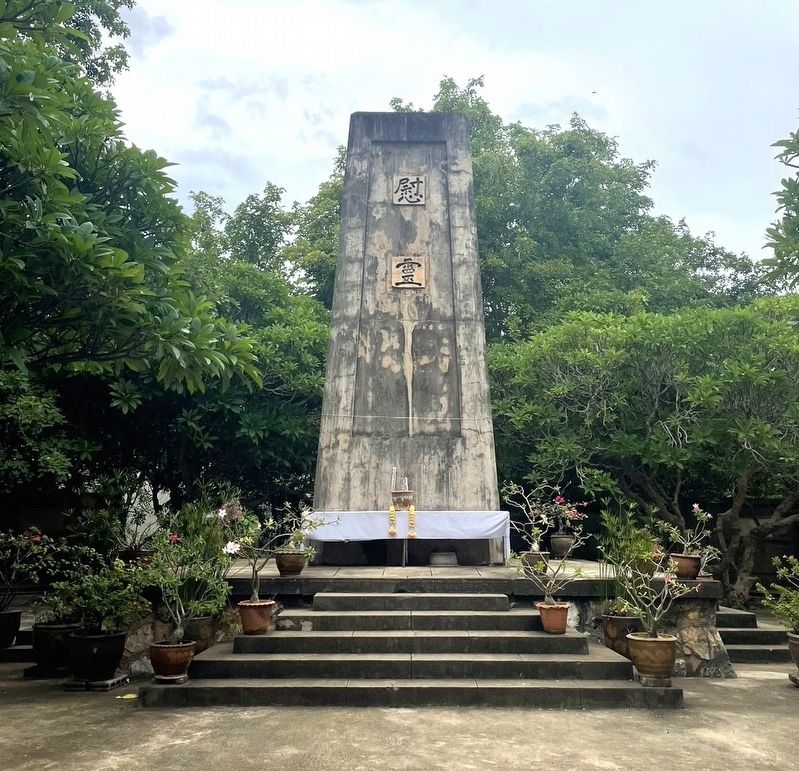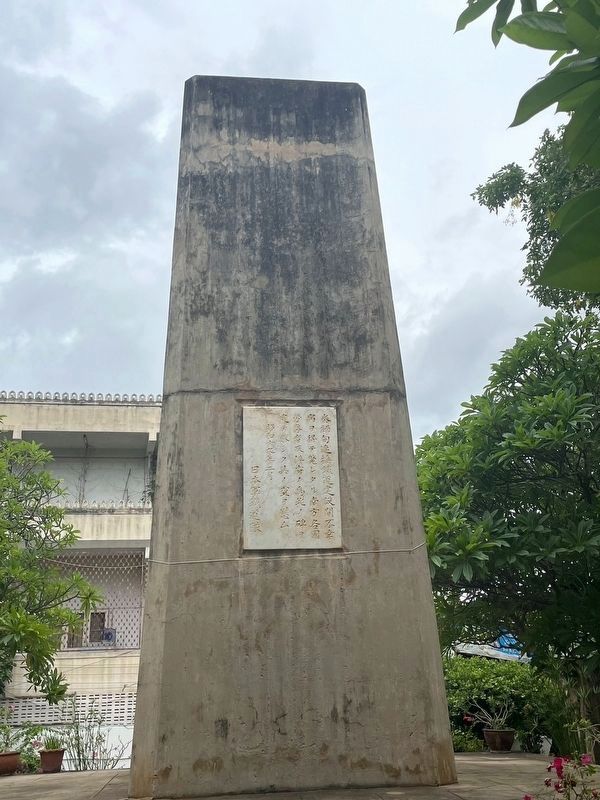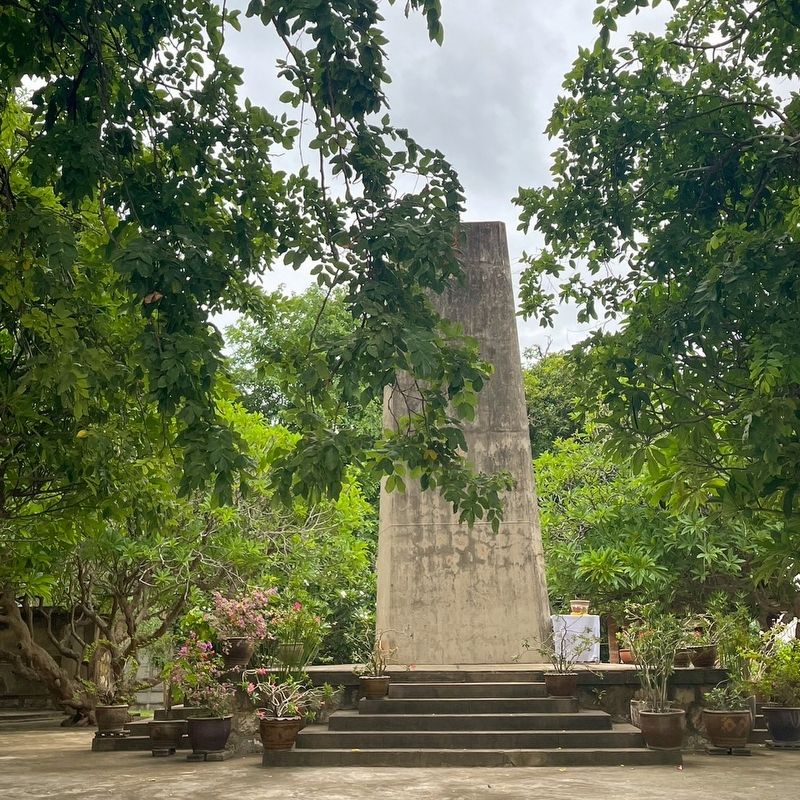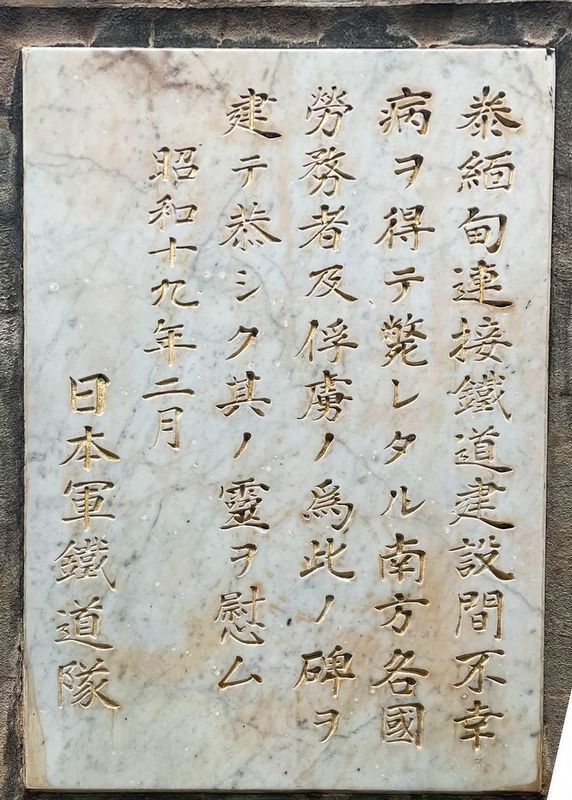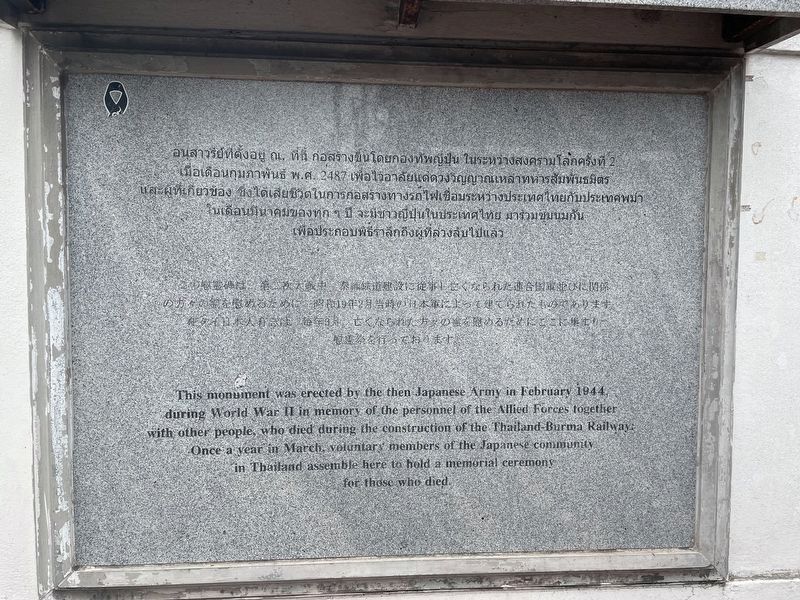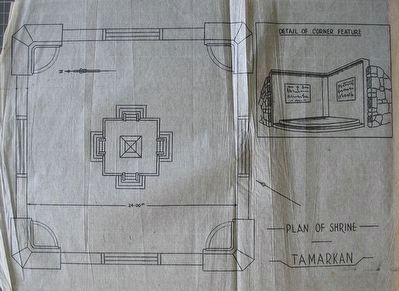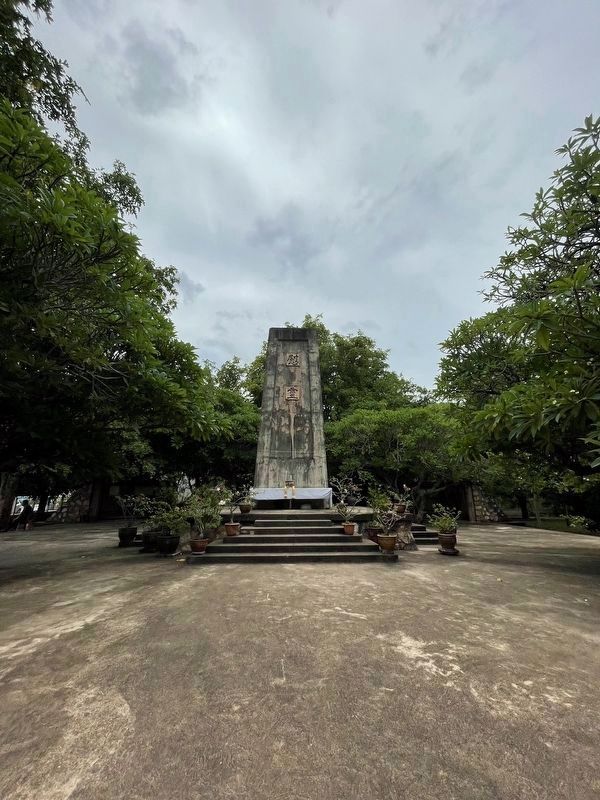Tha Ma Kham in Amphoe Mueang Kanchanaburi, Kanchanaburi, Thailand — ประเทศไทย (Southeast Asia, Indochinese Peninsula)
Thai-Anusorn
The Japanese Memorial to Rǒmusha and Prisoners-of-War
Inscription.
靈
“to comfort spirits”
(Japanese inscription on the reverse)
Misfortunes during the construction of the Thai-Burma railway link caused the death of laborers from southern countries and prisoners-of-war from illness. This memorial to their sacrifice is built to console their spirits.
—February, Shōwa 19, Japanese Military Railways
(plaque at street entrance to monument)
This monument was erected by the then Japanese Army in February, 1944, during World War II, in memory of the personnel of the Allied Forces together with other people, who died during the construction of the Thailand-Burma Railway. Once a year in March, voluntary members of the Japanese community in Thailand assemble here to hold a memorial ceremony for those who died.
Erected 1944 by the Imperial Japanese Army Railway Corps during World War II, while the war was still raging. Laborers that built it were Allied prisoners-of-war.
Topics and series. This memorial is listed in these topic lists: Railroads & Streetcars • War, World II. In addition, it is included in the The Thailand-Burma Railway series list.
Location. 14° 2.485′ N, 99° 30.33′ E. Marker is in Tha Ma Kham, Kanchanaburi, in Amphoe Mueang Kanchanaburi. Memorial is on River Kwai Road west of Myanmar Road, on the left when traveling west. It is opposite the Kanchanaburi City Hotel.
This memorial is quite near the northern end of the River Khwae railroad bridge that many of the souls memorialized here
help build.
. Touch for map. Marker is at or near this postal address: 372 Khwae Yai Rd, Tha Ma Kham, Kanchanaburi 71000, Thailand. Touch for directions.
Other nearby markers. At least 8 other markers are within 3 kilometers of this marker, measured as the crow flies. Burma-Thai Railway (about 150 meters away, measured in a direct line); VFW POW Kanchanaburi Memorial (about 150 meters away); The Bridge Over the River Kwae (about 180 meters away); The Kanchanaburi Memorial (approx. 2.4 kilometers away); Kanchanaburi War Cemetery (approx. 2.4 kilometers away); That Valiant Company Who Perished While Building the Railway (approx. 2.4 kilometers away); Tribute to Royal Dutch East Indies Army and the Royal Netherlands Navy Personnel Who Perished (approx. 2.5 kilometers away); Memorial to Dutch Prisoners of War (approx. 2.5 kilometers away). Touch for a list and map of all markers in Tha Ma Kham.
More about this marker. This monument is named in the title on the Thai language tablet in its northeast corner, ไทย อนุสรณ์ , which transliterates to “Thai-anusorn.” “Anusorn” means “memorial.” It has also been called the “Tamarkan Shrine” and the “Shrine at Tamarkan," for its location, the section of Kanchanaburi known as Tha Ma Kham.
Rōmusha (労 務 者) is a Japanese language word for “laborer.” In English, it usually refers to Asian non-Japanese unpaid conscripted laborers who were forced to work for the Japanese military during World War II.
Shōwa 19 indicates the 19th year of the Shōwa era, or 1944. The Shōwa era (昭 和) was the period of Japanese history corresponding to the reign of Emperor Shōwa (commonly known in English as Emperor
Hirohito).
The memorial was sited so it could be seen from trains crossing the nearby railway bridge that had been built by conscripted laborers and prisoners of war, the dead of which are memorialized here. Unfortunately, in recent years buildings have been built that block the view.
Regarding Thai-Anusorn. Soon after the completion of the Thai-Burma Railway in 1943, Major General Ishida Ekuma, Commander of the 2nd Railway Administration headquartered at Kanchanaburi, conceived the idea of a memorial dedicated to those who died “in the service of the Emperor.” He wanted it positioned so that those crossing the bridge would readily see it. A small patch of ground barely 150m from the iron bridge was secured and prisoners-of-war ‘volunteered’ to help build his memorial using materials left over from the bridge construction.
In
March 1944, before a large gathering of POWs and local Thai dignitaries and military leaders, a Japanese Shingon Buddhist monk, dedicated the memorial. Its two simple Chinese characters could be translated as “memorial to comfort of the spirits”. On the obverse, the text states that it is dedicated to the Asian foreign laborers and prisoners of war who died during this project.
In addition to the cenotaph, there are four corner structures containing inscriptions in languages of those involved in constructing the Railway.
In Feb 1945, the memorial was hit by bombs that missed their aiming point and fell on it and the nearby POW camp killing a number of Dutch POWs. When repairs were made*, a lack of plans or records resulted in a failure to replicate the original form of one of those corners.
As it stands today, it is one of the most enigmatic and mis-understood
monuments of this era.
* Photographs show that these repairs were made before 1952 but exactly when and by whom is not recorded.
Also see . . . Thai-Anusorn Memorial. Musings on the memorial, its name, and its inscriptions. (Submitted on July 2, 2023.)
Additional commentary.
1. Who are commemorated?
The inscription mentions the approximately 12 thousand Allied POWs and an untolded number (perhaps in excess of 100 thousand) of “Southern people” who died while working the Thai-Burma Railway. Those “Southern people” were primarily Tamil-Indians from Malaya along with ethnic Chinese from both Malaya and Singapore. There were also uncounted but smaller numbers of Thai, Javanese and even Vietnamese, These Asian Forced Laborers are collectively referred to
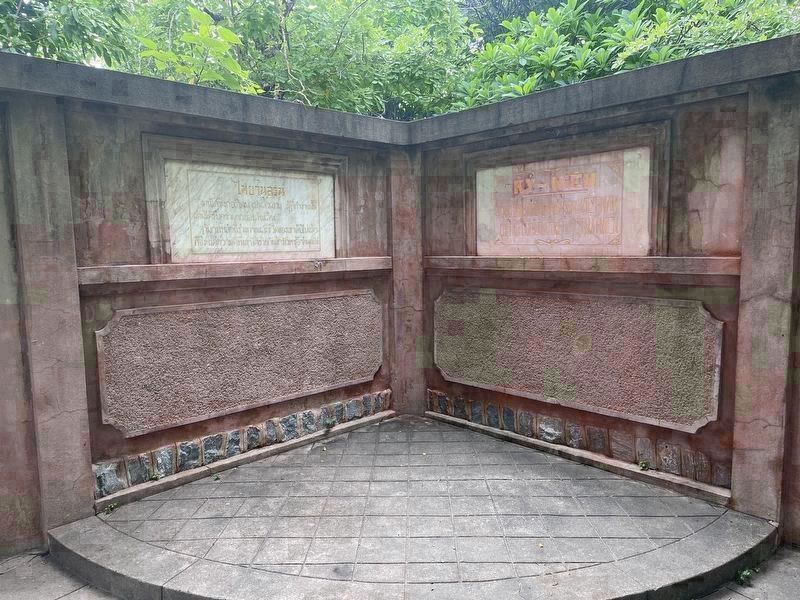
Photographed By Jj Karwacki, July 4, 2023
7. Northeast Corner,
the Thai and Vietnamese Corner of the Memorial
the Thai and Vietnamese Corner of the Memorial
This corner is the first on your left as you enter from the street. The Thai inscription on the tablet on the left translates to:
The Vietnamese inscription on the tablet on the right translates to:Thai-anusorn Any would say that what they did for the community is to be honored and praised. With respect to their bodies and souls—their lives—that were deceased, their merit cannot be extinguished. That is to say: it remains in our memorial.
Monument to the souls of the Vietnamese who died working on the Thai-Burmese railway.
— Submitted June 13, 2023, by Jj Karwacki of Tha Maka, Kanchanaburi.
Additional keywords. Tamarkan, Bridge on the River Kwai, thai-Burma Railway, Thailand-Burma Railway, Myanmar-Thailand Railway
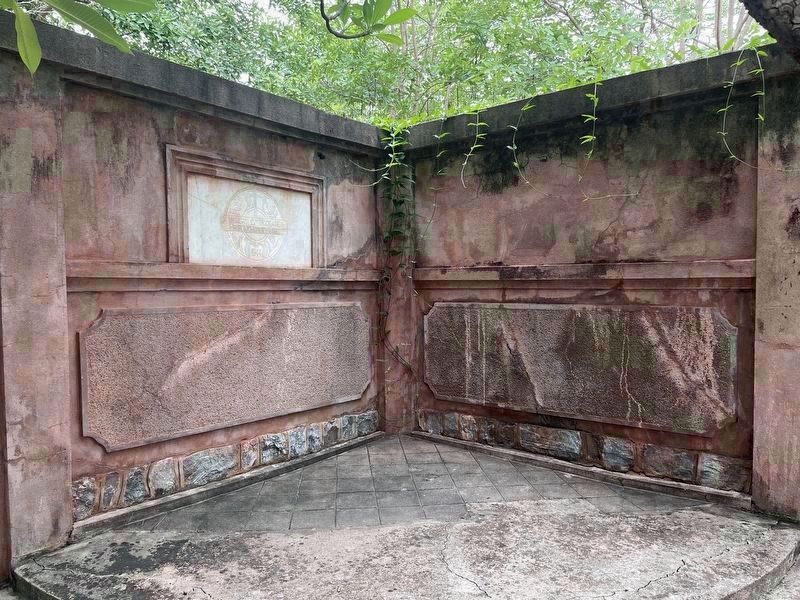
Photographed By Jj Karwacki, July 4, 2023
8. Southeast Corner,
the Damaged and Rebuilt Corner of the Memorial
the Damaged and Rebuilt Corner of the Memorial
This corner of the memorial was destroyed shortly after it was built, perhaps by a stray Allied bomb during one of the arial raids on the bridge. The corner was rebuilt, but only one of the original marble plaques, the one in English, on the left, was replaced, and likely with different text. The one on the right was not, and there is a debate as to which language it used. That it was in the Dutch language is the most prominent assumption.
The plaque on the left now reads,
The plaque on the left now reads,
Memory of Deceased Prisoners of Warsuperimposed over a circular funerary motif, which is dated 1944.
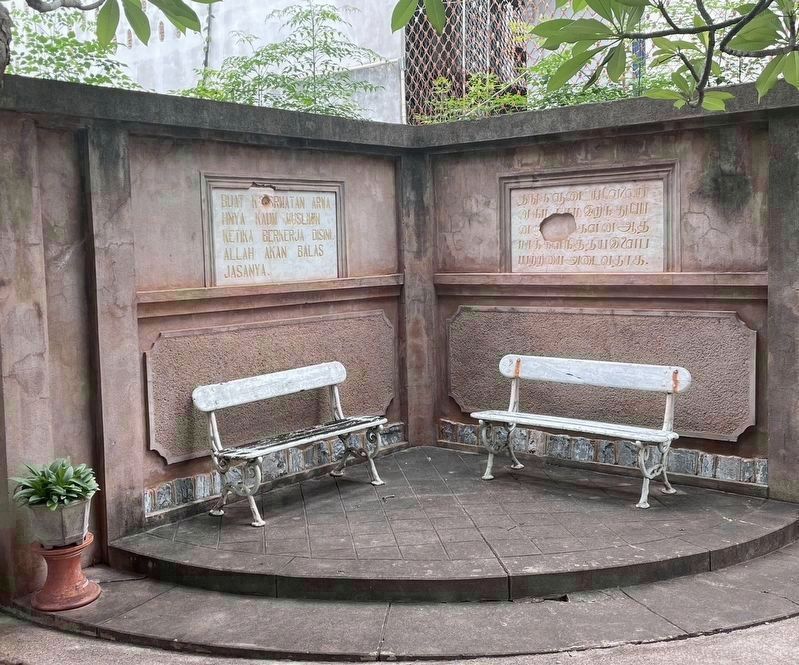
Photographed By Jj Karwacki, July 4, 2023
9. Southwest Corner,
the Sumatran and Tamil Corner of the Memorial
the Sumatran and Tamil Corner of the Memorial
The inscription on the left reads “BUAT K~~RMATAN ARWA HNYA KAUM MUSLIMIN KETIKA BERKERJA DISINI. ALLAH AKAN BALAS JASANYA.” This may be Sumatran rendered in the Roman script. This English translation is proffered by Professor David Boggett:
Paying our respects to the souls of Muslims who worked here. Allah will reward you.On the right the inscription is in the Tamil language,
To those who died during the work done here, may their souls be blessed. Om Ātman.
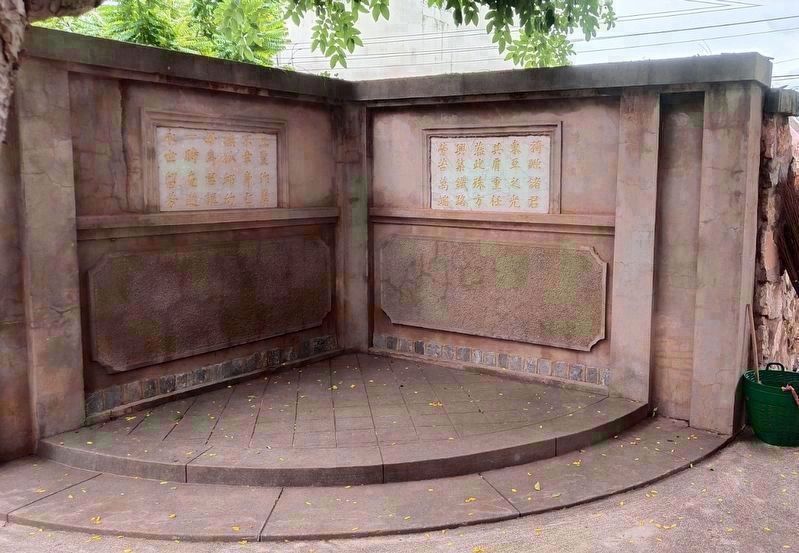
Photographed By Jj Karwacki, July 4, 2023
10. Northwest Corner,
the Japanese and Chinese Corner of the Monument
the Japanese and Chinese Corner of the Monument
The Japanese on the left panel appears to be a fragment of an ancient poem that is very esoteric and therefore next to impossible to translate. This is a poor attempt:
Peerless Mother, protect from evil children these kingly souls as they leave the body of the dying.The Chinese on the right panel translates to:
Ah, these poor people, / The glory of East Asia, / Working together on this great project, / They arrived at this special area / To begin building the railway, / And they toiled and suffered so very much.
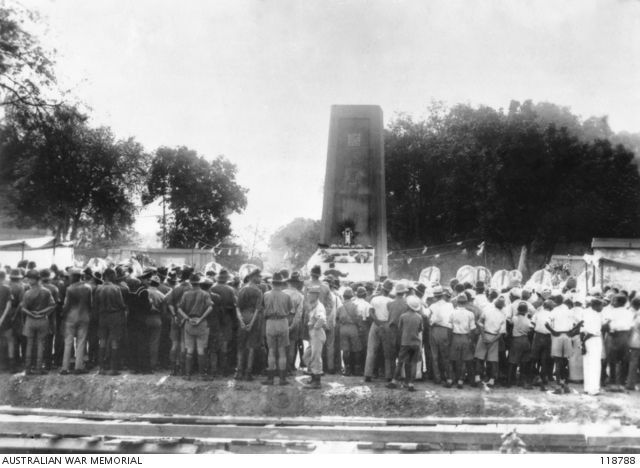
Australian Government photograph (Public Domain), March 13, 1944
12. Memorial's Dedication Ceremony, 1944
Japanese Major General Ishida Ekuma reads the Emperor’s “Mourning Epistle” at the dedication of the memorial. It translates to,
This ceremony invites the souls of those who sacrificed their lives for great benefit to create a presence at the monument. This is evident to you, the honourable, here. Is is regrettable they died as a result of suffering from illness. / I have prayed for the grace of Sri Rattanatrai and the sacred things in the world to protect them. / But despite this fervent effort, it cannot inspire you out of harm’s way, which is deeply saddening. / Their families, too. It is difficult to break their hearts in the sadness of remembering their kins who passed away. / However. Every human being, every name's life, must be as defined by heaven above. / Mourn in the spirit of those who devote their lives to fighting against, Lord Majesty, and bring peace to them. / As a result, the construction of railroads to provide a safe inland connection is another sign for the permanent and peaceful peace on earth. The world has always known for its perpetuality. / In conclusion, may those souls which dwell in heaven come down to dwell in this monument, to protect and inspire peace on this earth.Present are Allied Prisoners of War, Japanese guards, and local inhabitants.
Credits. This page was last revised on July 15, 2023. It was originally submitted on June 10, 2023, by Jj Karwacki of Tha Maka, Kanchanaburi. This page has been viewed 160 times since then and 45 times this year. Photos: 1, 2, 3, 4, 5, 6, 7, 8, 9, 10, 11. submitted on July 4, 2023, by Jj Karwacki of Tha Maka, Kanchanaburi. 12. submitted on July 2, 2023, by J. J. Prats of Powell, Ohio. • J. J. Prats was the editor who published this page.
Editor’s want-list for this marker. A photo of the street entrance to the monument. • Can you help?
